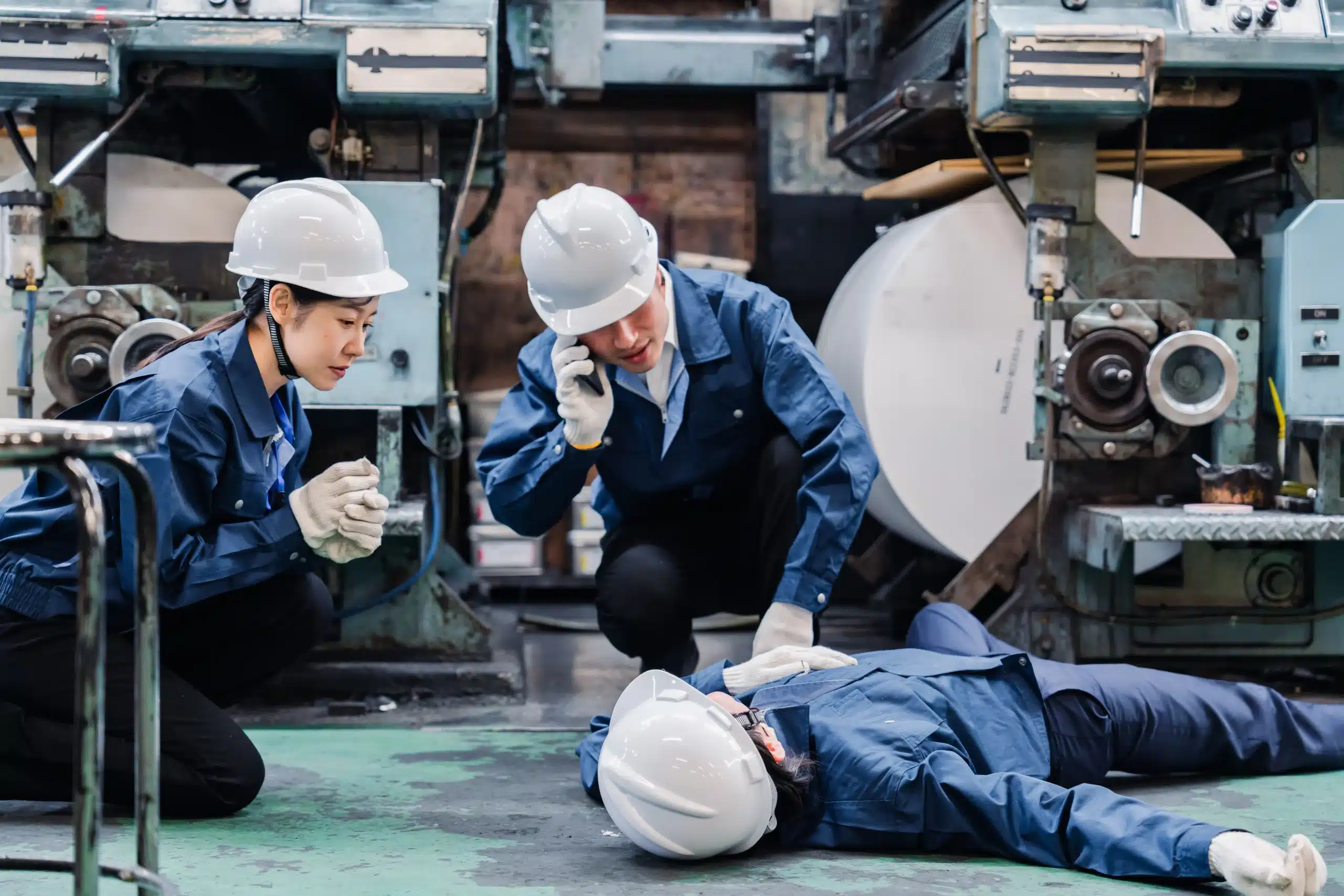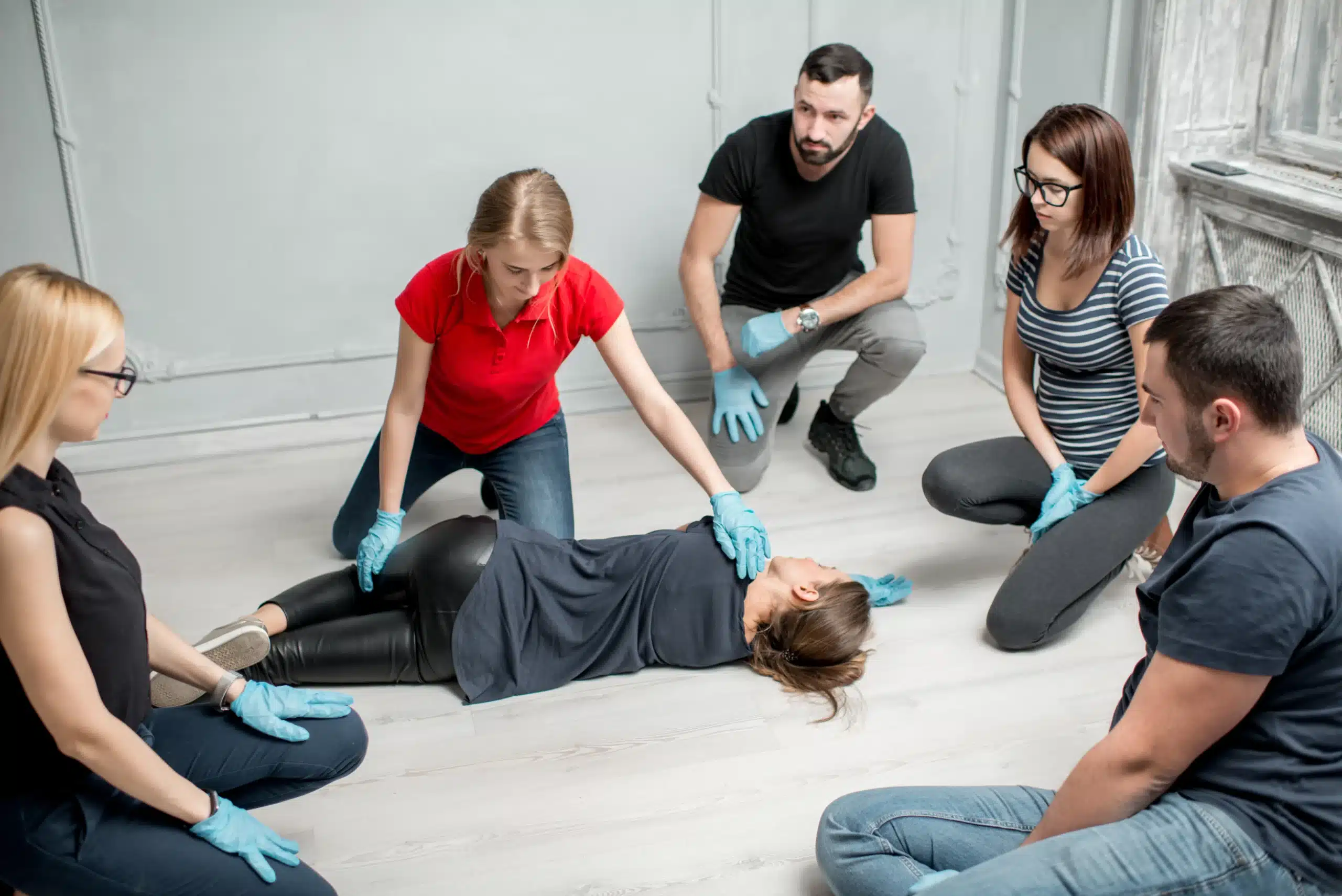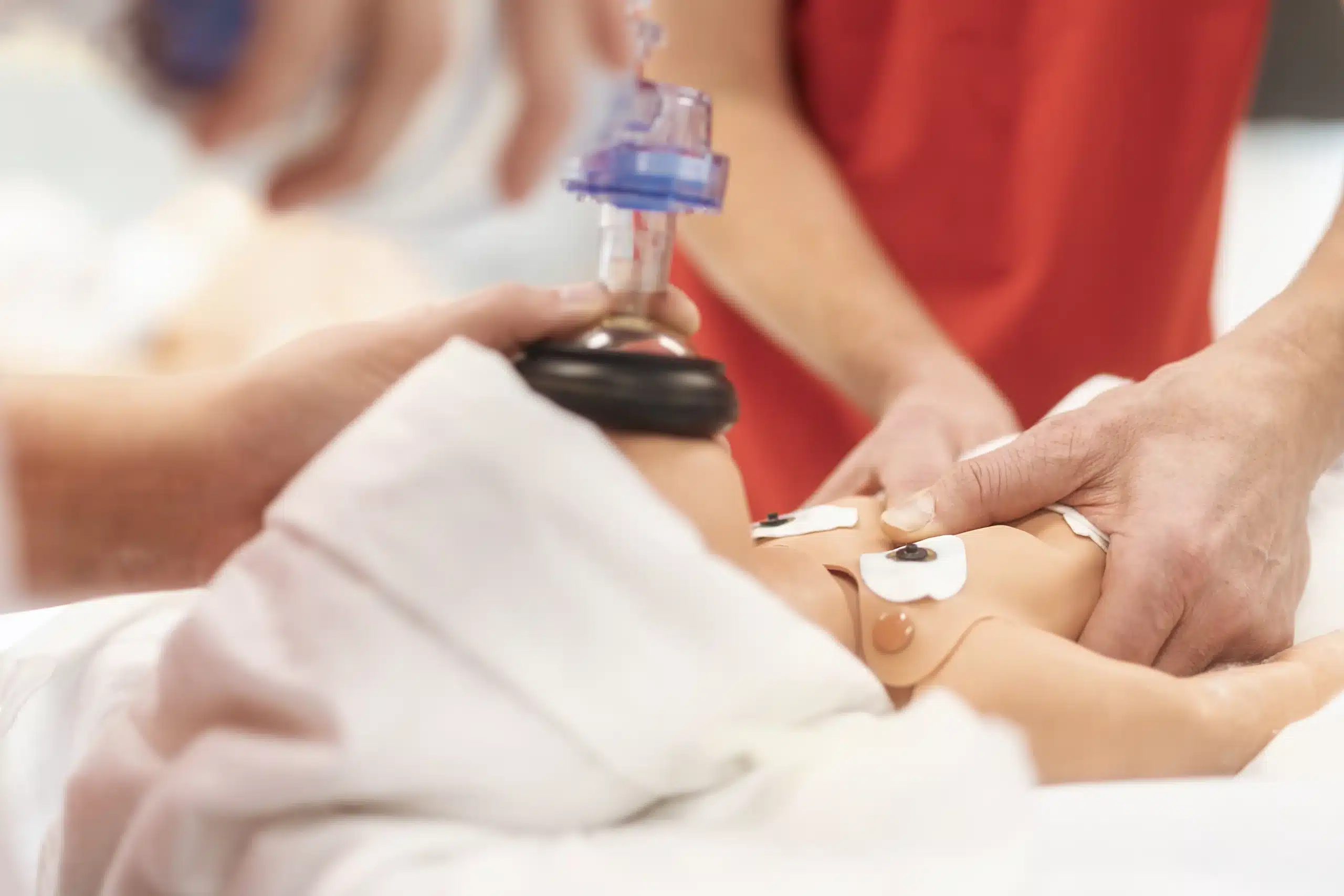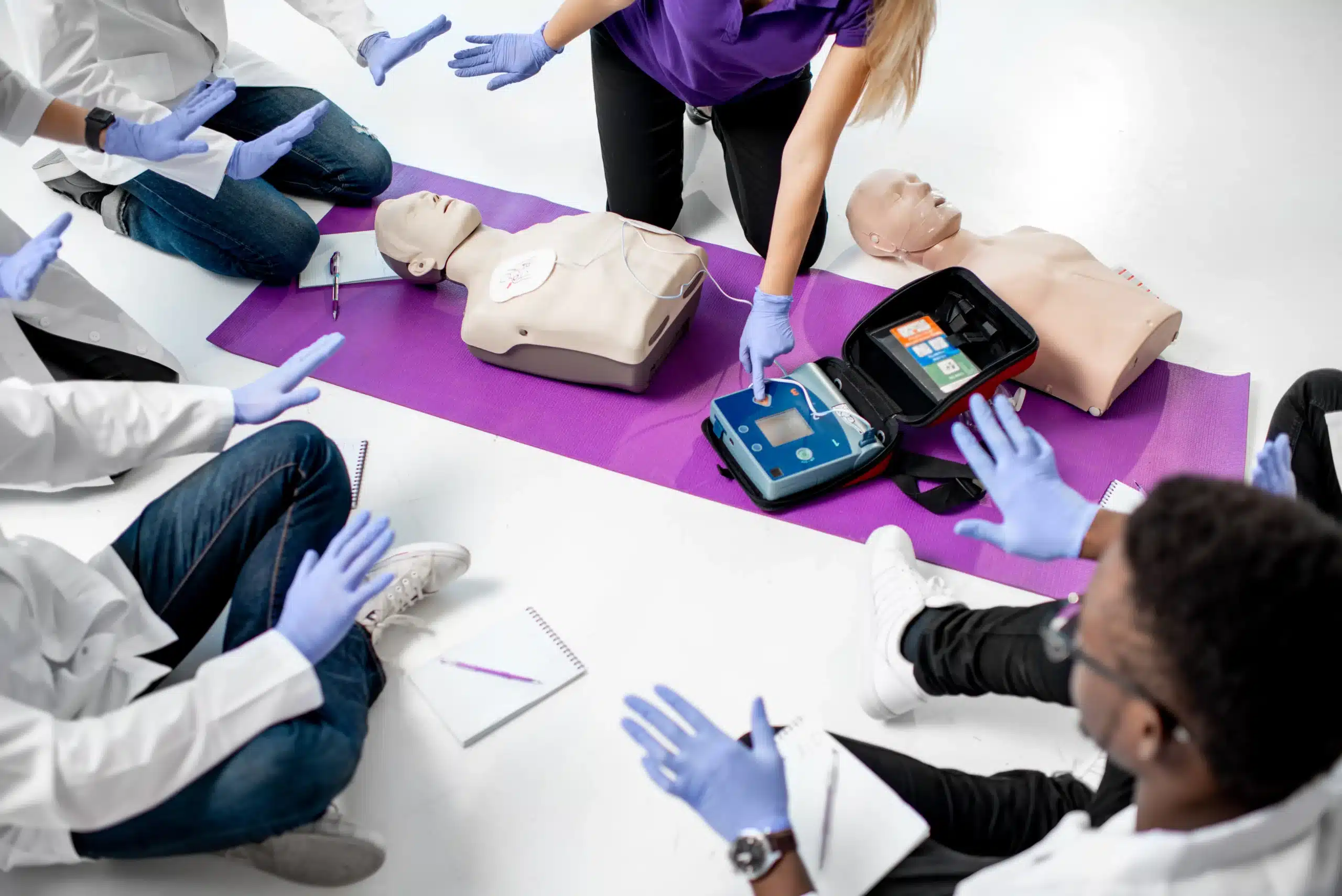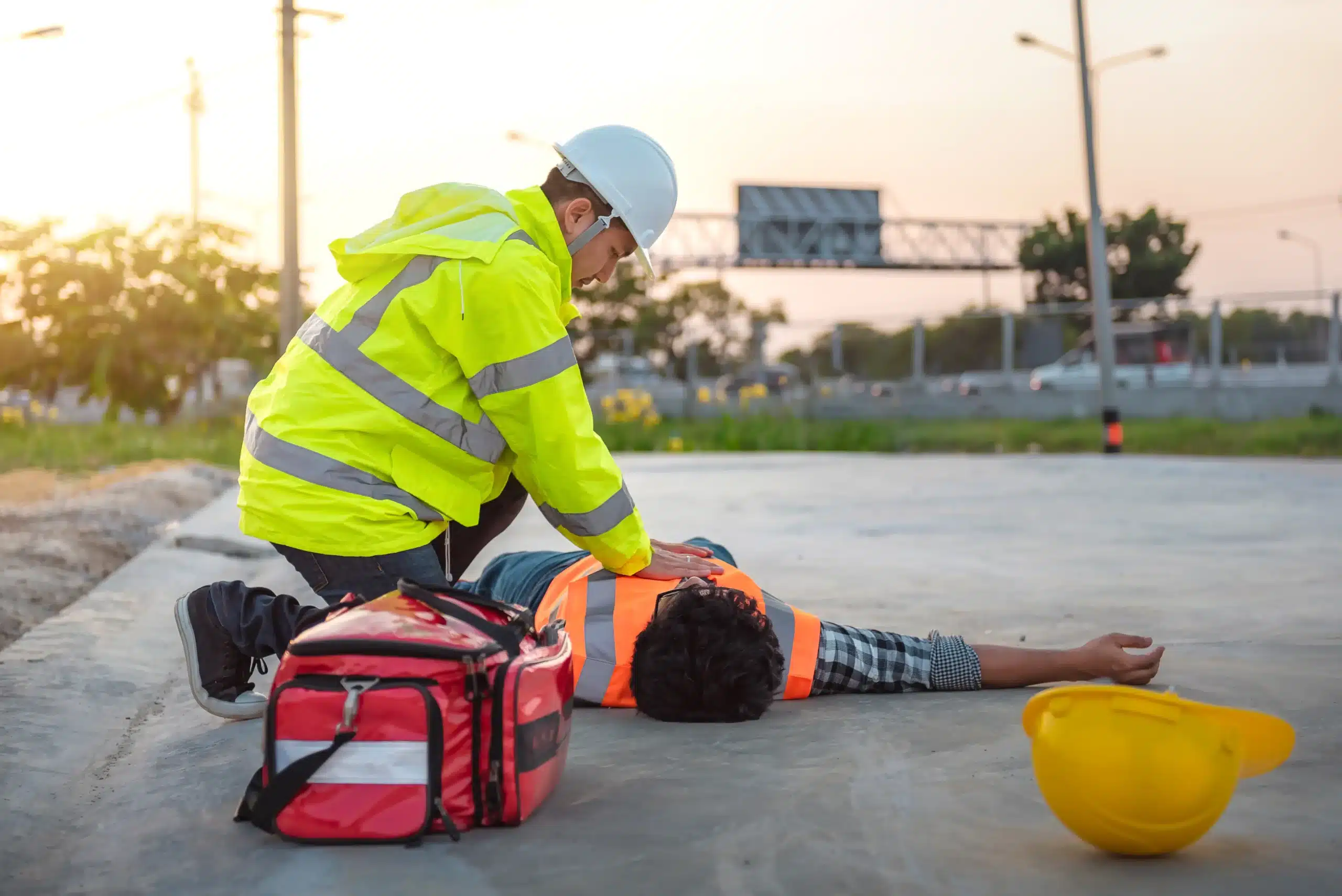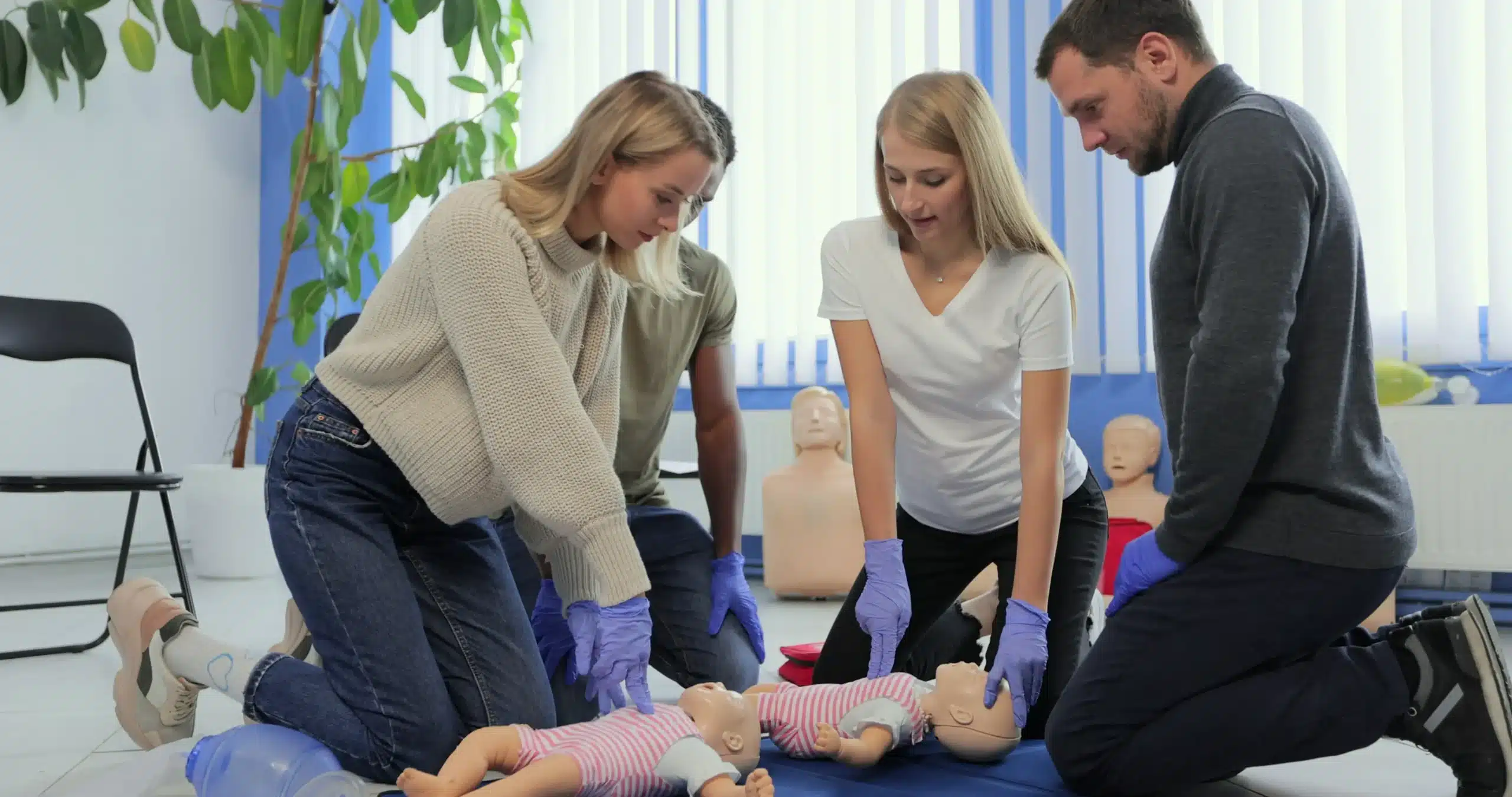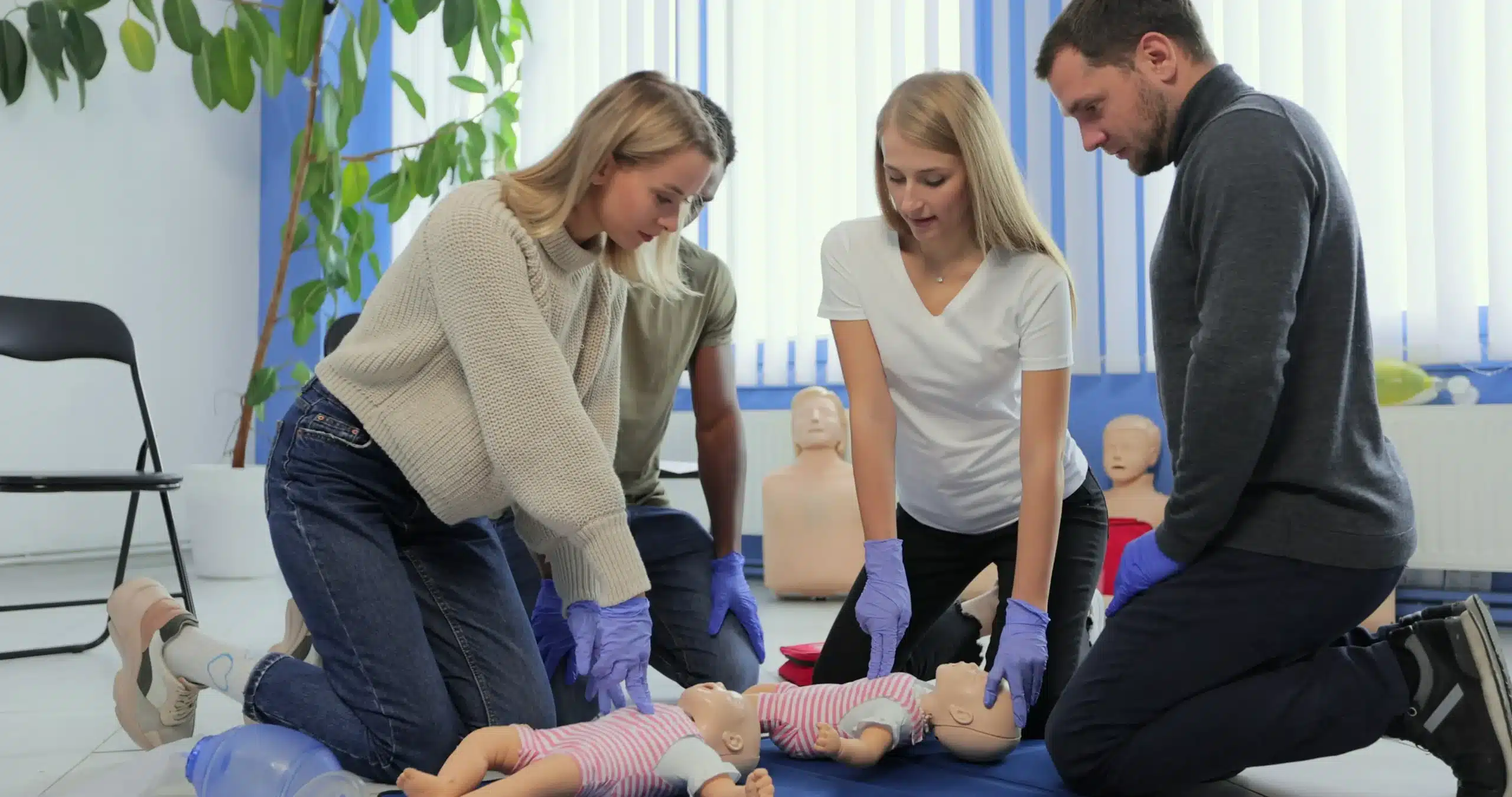CPR—two simple letters that represent the power to make a profound difference in someone’s life. In Alameda, the need for readily available CPR-trained individuals is paramount, given the high incidence of out-of-hospital cardiac arrests. This article will be your go-to resource for finding CPR classes in Alameda that fit your schedule and learning style. We’ll cover everything from basic CPR and First Aid training to more specialized certifications like BLS, ACLS, PALS, and NRP. We’ll also discuss the importance of hands-on training, the role of certified instructors, and how to navigate the costs associated with CPR certification.
Key Takeaways
- CPR knowledge saves lives: Equipping yourself with CPR skills significantly increases the chance of survival for someone experiencing cardiac arrest, especially since most out-of-hospital cardiac arrests occur in the presence of bystanders.
- Find the right CPR training in Alameda: Safety Training Seminars offers various AHA-certified courses, including BLS, ACLS, PALS, and NRP, conveniently located in Oakland and serving the Alameda and Berkeley communities. They also provide group discounts and a low-price guarantee.
- Tailor your training to your needs: Whether you’re a healthcare professional, a parent, or simply a community member, select a CPR class that aligns with your specific requirements. Look for courses offering hands-on practice, flexible schedules, and certified instructors.
What is CPR and Why is it Important in Alameda?
Cardiopulmonary Resuscitation (CPR) is a life-saving technique used when someone’s breathing or heartbeat stops. It combines chest compressions and, sometimes, rescue breaths. These actions circulate blood and oxygen to vital organs until professional medical help arrives. Learning CPR is crucial, as it can dramatically improve survival rates during cardiac emergencies.
In Alameda, about 70% of cardiac arrests happen outside of hospitals, making bystander CPR incredibly important. Knowing how to perform CPR can double or even triple a victim’s chance of survival. This makes it essential for community members to acquire these skills. CPR and First-aid certification are increasingly valuable for anyone wanting to make a difference in their community. These classes equip individuals with life-saving skills and foster a culture of preparedness for emergencies.
Current American Heart Association (AHA) guidelines recommend compression-only CPR. It’s important to find training that reflects these updated best practices. This change emphasizes the importance of staying informed and current on CPR techniques. For residents of Alameda, Oakland, and Berkeley, Safety Training Seminars offers courses that align with these guidelines.
CPR and First Aid Courses in Alameda
Safety Training Seminars offers a variety of CPR and first aid courses in Alameda, designed to meet the needs of healthcare providers, community members, and workplace requirements. Whether you’re a medical professional seeking recertification or a parent wanting to learn essential lifesaving skills, we have a course for you. We offer convenient training options in Oakland, serving the surrounding areas of Alameda and Berkeley. Check out our group discounts for additional cost savings.
BLS Certification
Basic Life Support (BLS) certification is crucial for healthcare professionals and anyone responding to cardiac arrest and other emergencies. Our BLS certification course covers core skills like CPR, using an AED, and relieving choking. We adhere to the American Heart Association guidelines, ensuring high-quality training.
ACLS
Advanced Cardiovascular Life Support (ACLS) training builds upon BLS skills, focusing on advanced interventions for adult patients experiencing respiratory or cardiac arrest. This ACLS course is designed for healthcare providers, including physicians, nurses, and paramedics, who manage cardiovascular emergencies.
PALS
Pediatric Advanced Life Support (PALS) certification equips healthcare providers with the knowledge and skills to respond to life-threatening emergencies in infants and children. Our PALS course covers essential topics such as pediatric assessment, airway management, and resuscitation techniques.
First Aid Training
First aid training provides essential skills to manage common injuries and illnesses. Learn how to respond to cuts, burns, fractures, and other medical situations. Combine first aid training with CPR certification for a comprehensive approach to emergency preparedness.
NRP
The Neonatal Resuscitation Program (NRP) course prepares healthcare professionals to care for newborns requiring respiratory support immediately after birth. This specialized NRP training covers essential resuscitation techniques and stabilization strategies for newborns.
Find CPR Classes in Alameda
If you’re searching for “CPR classes near me” in Alameda, you have several options. Finding the right CPR class depends on your needs, schedule, and budget. Here’s a breakdown of CPR training providers in Alameda:
Safety Training Seminars Location
Safety Training Seminars offers a variety of American Heart Association (AHA) courses in Alameda. You can find CPR and First Aid certification, along with more advanced courses like BLS, ACLS, and PALS. They also offer convenient online components combined with in-person skills testing. Check their website for more information on CPR classes in Alameda. For larger groups, Safety Training Seminars also offers group discounts.
Other Training Centers in the Area
Besides Safety Training Seminars, Alameda has a few other training centers worth considering:
Lifesavers CPR & First Aid
Lifesavers CPR & First Aid provides CPR and first aid certification courses, and also sells AED equipment and manages AED programs. They serve the broader San Francisco Bay Area, so if you’re outside Alameda, they might be a good option.
CPR Education
CPR Education focuses on practical skills and current techniques for CPR and first aid training in Alameda. They’re known for their experienced instructors and flexible scheduling. You can find their class schedule and registration information online.
Alameda CPR Classes
Alameda CPR Classes offers daily classes at their Alameda location. They’re an AHA Training Center and offer classes in over 60 Northern California cities. Visit the Alameda CPR Classes website for details.
Cost of CPR Classes in Alameda
Knowing the cost is an important factor when choosing a CPR class. Several things influence pricing, including the type of course, group discounts, and whether the provider offers a low-price guarantee.
Course Pricing
CPR class prices in Alameda vary depending on the certification level you need. A combined CPR and First Aid certification course may cost around $140, covering online instruction, in-person skills assessment, and your certification card. It’s a convenient way to get certified in both areas at once. For specific pricing on individual courses like BLS, ACLS, and NRP, check with providers like Safety Training Seminars. Remember to confirm exactly what’s included in the quoted price.
Group Discounts and Special Offers
If you’re certifying a group, look for discounts. Some providers, like Lifesavers CPR and First Aid, offer promotions and group discounts. You might find deals that bundle equipment purchases with free or discounted certifications. Safety Training Seminars also offers group discounts, so contact them to discuss your specific needs. This can be a smart way to train your team or family and save money.
Low Price Guarantee
Finding affordable training is important. Look for providers with a low-price guarantee, like Alameda CPR Classes. This ensures you’re getting a competitive price. Safety Training Seminars also has a low-price guarantee, making quality CPR training accessible. Knowing you’re getting a good deal can simplify choosing a class.
CPR Instructor Qualifications
Choosing the right CPR instructor is just as important as choosing the right class. You want someone who can give you the confidence and skills to act in an emergency. Here are two key things to look for:
AHA Certification
The American Heart Association (AHA) sets the standard for CPR training. Make sure your instructor is AHA-certified. This means they’ve completed a rigorous training program and are up-to-date on the latest guidelines. AHA-certified instructors follow a specific curriculum, ensuring you receive consistent, high-quality instruction. This certification demonstrates a commitment to excellence and gives you peace of mind knowing you’re learning from a qualified professional. Safety Training Seminars offers courses taught by AHA-certified instructors, covering everything from basic CPR to more advanced certifications like ACLS. You can find more information on our BLS certification page.
Healthcare Backgrounds
While not strictly required, an instructor with a healthcare background can offer valuable real-world experience. Nurses, paramedics, and other medical professionals often have a deeper understanding of emergency situations. They can share firsthand insights and answer your questions from a practical perspective. This experience can make the training more engaging and help you connect classroom learning to real-life scenarios. Consider this when choosing your instructor, especially if you’re pursuing CPR certification for a healthcare-related career. Our instructors at Safety Training Seminars often come from diverse healthcare backgrounds, enriching the learning experience for our students.
CPR Course Duration and Certification
CPR and first aid training are essential skills, but how long does it take to get certified, and how long is your certification good for? Let’s break down the typical process and what you can expect.
Course Length
Combined CPR and first aid certification courses often streamline the process. For example, a combined course, like the one offered by Alameda CPR Classes, includes online instruction and an in-person skills test. This blended learning approach lets you learn the material at your own pace online and then demonstrate your skills in person. This combined CPR and first aid course usually takes a few hours to complete.
Two-Year Certification
CPR certifications, including those from the American Heart Association, are typically valid for two years. This timeframe helps ensure certified individuals maintain current knowledge and skills. Regular renewal reinforces best practices and incorporates any guideline updates.
Recertification
After two years, recertification is required to keep your CPR credentials current. The recertification process is similar to the initial certification and often involves reviewing the material and a skills demonstration. This ensures you’re always prepared to respond effectively. Many training centers, like CPR Classes in Alameda, offer recertification courses. After completing the course, you’ll receive an updated certification card, valid for another two years.
What Happens in a CPR Class?
CPR classes blend theory and practical skills to prepare you for real-life emergencies. You’ll learn the steps of CPR, how to recognize the signs of a cardiac arrest, and how to respond effectively. Let’s break down what you can expect during your training.
Hands-on Training
Hands-on practice is the core of any good CPR class. You’ll work with training manikins to practice chest compressions and rescue breaths. This hands-on training helps you develop muscle memory and understand the correct depth and rhythm for compressions. Instructors provide feedback and guidance, ensuring you’re comfortable and confident performing CPR. This experience is invaluable for preparing you to act quickly and effectively in a real emergency.
Written Exams
Most CPR classes include a written exam to assess your understanding of the material. These exams cover topics like CPR steps, recognizing cardiac arrest, and providing appropriate care. The questions focus on practical application, not rote memorization. The goal is to ensure you grasp the principles behind CPR to help you adapt to different situations. Combined CPR and First Aid certification courses often include a written exam with a practical skills test.
Online and In-Person Options
CPR classes offer flexibility to fit your schedule and learning style. In-person classes provide direct interaction with instructors and classmates, allowing for immediate feedback and personalized guidance. Online options offer convenience and self-paced learning, often incorporating videos and interactive modules. Many programs, like the American Heart Association RQI program, blend online learning with in-person skills sessions. This blended approach lets you learn the material at your own pace and then demonstrate your skills to a certified instructor. Regardless of the format, ensure your chosen course leads to a recognized certification, such as one from the American Heart Association.
Benefits of CPR Certification
Getting CPR certified offers a range of advantages, from personal and professional growth to making a real difference in your community. Knowing you have the skills to potentially save a life brings a sense of confidence and preparedness. Let’s explore some key benefits of becoming CPR certified.
Personal and Professional Advantages
CPR certification is an asset in many professions. For those in healthcare, education, childcare, or fitness, it’s often a job requirement. Even if not mandatory, having CPR certification on your resume demonstrates your commitment to safety and can give you an edge. Beyond career advancement, CPR training empowers you to respond effectively in emergencies, whether at home, work, or out in the community. This can make a profound difference in the lives of your loved ones and those around you. Plus, combined CPR and First Aid certification can be surprisingly affordable, with options available for around $140, including online instruction, in-person skills testing, and your certification card. The convenient same-day certification makes fitting this valuable training into your schedule even easier.
Community Impact
In a close-knit community like Alameda, being CPR certified can have a significant impact. Emergencies can happen anytime, and having trained individuals readily available can dramatically improve outcomes. CPR and First Aid training equips community members with the skills to respond to crises and potentially save lives, strengthening the overall safety net within Alameda. These skills are invaluable, empowering individuals to act quickly and confidently in critical situations, making Alameda a safer place for everyone. Knowing that your neighbors and fellow community members are trained to respond in emergencies fosters a sense of collective security.
Meeting Requirements
Many professions require CPR certification to ensure workplace safety and compliance. OSHA-compliant certifications, such as those offered by ASHI, are often necessary for jobs in healthcare, construction, education, and other fields. These certifications typically remain valid for two years. Choosing an AHA-authorized training center with experienced instructors ensures you receive high-quality training that meets industry standards. Look for programs that offer flexible scheduling and a variety of courses to fit your specific needs. Staying current with your certification demonstrates your commitment to maintaining these essential life-saving skills.
Common CPR Training Misconceptions
It’s easy to get confused about CPR, especially with so much information (and misinformation) out there. Let’s clear up a few common misconceptions so you can feel confident in your training and abilities.
“Only Medical Professionals Can Perform CPR”
One of the biggest myths about CPR is that it’s only for doctors and nurses. This simply isn’t true. Anyone can learn CPR—parents, teachers, coaches, office workers—anyone. In fact, bystander CPR can dramatically increase someone’s chances of survival during cardiac arrest. Don’t let this myth stop you from taking action in an emergency. Learning CPR empowers you to help save a life. Our BLS certification course is a great place to start.
“CPR Restarts a Stopped Heart”
Another misconception is that CPR restarts the heart. CPR is crucial for maintaining blood flow and oxygen to the brain and vital organs, giving first responders time to arrive. It keeps the body alive, but it doesn’t restart the heart. That usually requires a defibrillator or other advanced medical intervention. Understanding this difference helps you respond more effectively and understand the true purpose of CPR. It’s about buying time and keeping someone alive until professional help arrives. Our ACLS course goes into more detail about how CPR works.
“Online CPR Training is Enough”
While online CPR training can be a convenient way to learn the basics, it shouldn’t replace hands-on practice. Think of it like learning to ride a bike—you can read all about it, but you won’t truly know how until you actually do it. The same applies to CPR. Physical practice and feedback from a certified instructor are essential for developing the muscle memory and confidence you need to perform CPR effectively in a real emergency. Our in-person classes offer the hands-on training you need to be fully prepared.
Choose the Right CPR Class
Choosing the right CPR class is crucial for effective learning and preparedness. It’s not a one-size-fits-all situation; the best class for you depends on your individual circumstances and goals. Here’s a breakdown of how to find the perfect fit:
Assess Your Needs
Before you start searching for CPR classes, take a moment to consider why you need this training. Are you a healthcare professional required to maintain certification? A parent wanting to be prepared for emergencies at home? A teacher looking to enhance safety in the classroom? Understanding your motivation will guide you toward the right course. For example, healthcare providers often require BLS certification, while a community member might benefit from a general CPR and First Aid course. Also, consider whether you prefer in-person instruction or the convenience of online learning. We offer both options to accommodate different learning styles and schedules.
Compare Courses
CPR training encompasses various levels and specializations. ACLS (Advanced Cardiovascular Life Support) is designed for healthcare professionals responding to cardiovascular emergencies, while PALS (Pediatric Advanced Life Support) focuses on the specific needs of infants and children. NRP (Neonatal Resuscitation Program) caters to healthcare providers involved in neonatal care. Understanding the distinctions between these courses will help you select the one that aligns with your professional goals or personal needs. Our website provides detailed course descriptions, outlining the topics covered and the intended audience.
Flexible Scheduling
We understand that life gets busy, so we offer flexible scheduling options to make CPR training accessible to everyone. Our classes are available throughout the week and on weekends, with various time slots to choose from. Whether you’re a busy professional, a student, or a parent juggling multiple responsibilities, we can help you find a time that works for you. Check our website for a current schedule of classes and register for a course today. We also offer group discounts for businesses, organizations, and families who want to train together.
Related Articles
- Why CPR is Crucial in Healthcare
- The Importance of Workplace CPR & First-Aid Training
- CPR Certification in Oakland: Your Guide – Oakland CPR Classes
- BLS ACLS PALS Courses in Oakland: Your Complete Guide – Oakland CPR Classes
- Understanding Psychological Recovery for CPR Survivors
Frequently Asked Questions
What’s the difference between CPR and First Aid?
CPR focuses specifically on life-threatening situations where someone’s breathing or heart has stopped. First Aid covers a broader range of injuries and illnesses, from minor cuts and burns to more serious situations like choking or allergic reactions. Both are valuable skills to have, and many courses combine CPR and First Aid training for a comprehensive approach to emergency preparedness.
How do I choose the right CPR class in Alameda?
Finding the right CPR class depends on a few factors. Consider your specific needs – are you a healthcare provider needing recertification, or are you learning CPR for personal knowledge? Think about your schedule and preferred learning style (online or in-person). Finally, compare costs and what’s included in the course fee. Safety Training Seminars offers various options, including BLS, ACLS, and PALS, catering to different needs and schedules.
How long does it take to get CPR certified, and how long is the certification valid?
CPR certification courses vary in length, but a combined CPR and First Aid course can often be completed in a few hours. Certification is typically valid for two years, after which you’ll need to recertify to stay current with the latest guidelines.
What if I’m nervous about performing CPR in a real emergency?
It’s completely normal to feel apprehensive about using CPR in a real-life situation. That’s why quality training is so important. Hands-on practice with manikins during a CPR class helps build muscle memory and confidence. Plus, instructors can address your concerns and provide personalized feedback. Remember, even basic CPR can significantly improve someone’s chances of survival until professional help arrives.
Why should I choose Safety Training Seminars for my CPR training?
Safety Training Seminars offers high-quality, AHA-compliant courses in Oakland, conveniently serving Alameda, Berkeley, and surrounding areas. We have experienced, certified instructors, flexible scheduling options, and competitive pricing, including group discounts. We’re committed to providing comprehensive training that empowers you to act confidently in emergencies.


